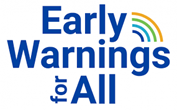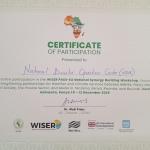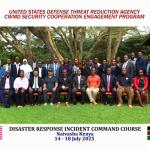National Workshop on Early Warning for All (EW4ALL) Initiative
Early Warning Systems are a proven, effective, and feasible disaster risk reduction and climate adaptation measure, that save lives and provide a tenfold return on investment. Yet, major gaps in early warning systems remain globally with Kenya not being an exception, especially when it comes to translating early warnings into risk-informed early action.
Early Warnings for All – a global initiative to ensure that everyone on Earth is protected by early warnings by 2027 – is being fast-tracked into action on the ground. The UN Secretary-General released in November 2022 the High-level Executive Action Plan for this initiative, emphasizing the urgent need to support the most vulnerable first. Following the High-level Action Plan, the Multi-Hazard Early Warning For All Action Plan for Africa (2023 – 2027) was developed.
Faced with increasing frequency and severity of climate and weather extremities that induce climate related disasters such as droughts and floods, there is a need for a clear framework to reduce the impacts of these climatic hazards that destroy livelihoods, investments and at times life has gathered pace. Such a framework requires a multi-faceted approach and institutionally led structure able to ensure timely and effective warnings, response and emergencies reach the entire population as envisaged in EW4ALL initiatives.
The EW4All comprises the four foundational pillars of early warning systems:
Pillar 1: Disaster risk knowledge - systematically collect risk data and undertake risk assessments on hazards and vulnerabilities to improve risk understanding.
Pillar 2: Observations and Forecasting - develop hazard monitoring and early warning services.
Pillar 3: Dissemination and communication - communicate risk information so it reaches all those who need it and is understandable and usable.
Pillar 4: Preparedness to respond - build national and community response capabilities.
While governments play a crucial role in driving action on early warning services for their citizens, adopting a "whole-of-society" approach that involves all stakeholders, including civil society and the private sector, can better strengthen and sustain early warning services. It is equally important to recognize that disasters and climate change affect people differently based on their gender, age, and other factors. By involving all sectors of society and taking an inclusive,intersectional approach, early warning services can be more effective in protecting vulnerable populations from the impacts of disasters and climate change.
Building on current and forthcoming initiatives like Strengthening Early Warning and Early Action in Kenya, the EW4All pillar leads and its partners are seeking to boost momentum collectively with the achievement of the EW4All Action Plan by 2027. Kenyan climate monitoring, observations forecasting, and disaster response capacities to better manage and get ahead of hazardous events are needed to protect and grow the wellbeing and resilience of vulnerable and exposed individuals and communities. The Country has made notable milestones including the completion and the cabinet approval of National Framework for Climate Services (NFCS-2023), Kenya Anticipatory Action Roadmap (2024-2029) and the National Disaster Risk Management bill of 2024 currently in the legislation process. However, the completeness of these initiatives requires participatory and an all-inclusive approach that ties the needs of the community, political good will and institutional collaborations that provides for a multi-stake platform for coordination, design, communication, and feedback of Early warning systems in Kenya.
It is in this context, national authorities of Kenya and stakeholders plan to undertake the national launch and consultation workshop on Early Warnings for All (EW4All) to develop a roadmap to consolidate and grow coverage of MHEWS to empower and enable early action by individuals and communities, especially those most in need.




